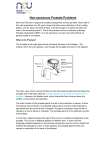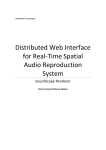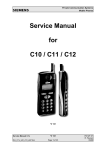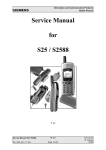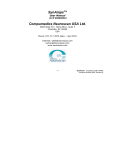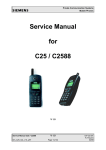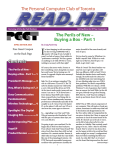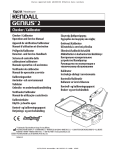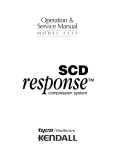Download Operating Manual - Sparrow Health System
Transcript
Operating Manual Section I General Information………………………………………………………2 & 3 Section II Operating Procedures………………………………………………….4 thru 9 Section III Intermittent Feeding Mode……………………………………………..10 & 11 Section IV Alarms…………………………………………………………………11 thru 13 Section V Cleaning………………………………………………………………….13 & 14 Section VI Trouble Shooting Guide………………………………………………………15 Section VII Factory Service………………………………………………………………..16 Section VIII Specifications…………………………………………………………17 thru 19 Section IX Limited Warranty………………………………………………………………20 1 SECTION I General Information The KANGAROO PET® Enteral Feeding Pump is a rotary peristaltic pump designed to regulate the flow rate of enteral feedings. Among the features provided by this pump are: • Small and lightweight for ambulatory operation – built in battery • Detachable charger base with permanently attached power chord and indicator light • “Quick-charge” feature fully recharges battery in 6 hours • Intermittent feeding mode allows repeated feedings at set periods • Wide range for dose to be delivered – • 16-hour memory of all settings when pump is off • Large LED display and touch panel data entry • Low occlusion pressure. Pump will not overcome back pressure greater than approximately 15 psi (103 kPa) • Integral pole clamp on base unit • Shut of and activation of audible and visible alarms when: • DC motor with intermittent operation • Volume delivered totalizer • Pump running indicator lights -1-75 ml in 1 ml increments -75-2000 ml in 5ml increments -Feeding container is empty -Feeding tube becomes occluded -Drop sensor is blocked -Battery low (alarms 15 minutes before pump shuts off) -Unit is left in “HOLD” mode longer than 2-½ minutes -Pump set is improperly loaded -Self diagnosed problem, which requires technical servicing -Preset dose has been delivered -Pump motor malfunctions • Use of safety interlock pump sets to prevent free flow from inadvertent misleading of pump set onto pump WARNING: this KANGAROO® PET Pump requires the use of a KANGAROO Pump Set. The pump will not operate if sets other than KANGAROO® Pump Sets are loaded onto the pump. 2 1. 2. 3. 4. 5. 6. 7. 8. 9. 10. Pump Upper Drip Chamber Guide Tubing Guide Lower Drip Chamber Guide Rotor Rotor Cover Loading Arm Arm Latch Keypad Display 11. Intermittent Feeding Indicator 12. Charger Base 13. Release Latch 14. Power Cord 15. AC Light 16. Pole Clamp Knob 17. Pole Clamp (back view) 3 SECTION II Operating Procedures Removing and Installing the Pump into the Charger Base Below are general instructions for inserting the Kangaroo Pet® Pump into its charging base. Remove the pump from the charging base by pressing down on the latch and pulling the pump away from the latch. Install the pump onto the charging base by aligning the grooves in the pump body with the guide in the charging base. Push pump onto the charging base until the pump is locked into place by the latch. ON Power the pump OFF Turns the pump off. The battery will charge even if the pump has been turned off assuming that the pump is in the charger base and the base is plugged into the wall outlet Increases the rate, dose or interval as desired. The numbers will change more rapidly if the key is continuously depressed. Decreases the rate, dose or interval as desired. The numbers will change more rapidly if the key is continuously depressed. VOL DOSE Temporarily displays the accumulated volume delivered since the last time the amount was cleared. When pressed, allows user to preset a dose to be delivered by pressing 4 or . SECTION II Operating Procedures INT Allows user to set start-to-start interval when pump is used in the intermittent feeding mode. For details on implementing intermittent feeding, see Section III. The dot in the upper left hand corner of the display will flash whenever the pump in the Intermittent Feeding Mode. This dot is indicated by the INT label above the display. CLR Clears the value being displayed (volume delivered; rate, dose or interval setting). Volume delivered cannot be cleared while pump is delivering a dose. During intermittent feeding the volume delivered can be cleared only when the pump is between feedings, and in HOLD mode. START / HOLD Starts pump rotor to deliver feeding formula to patient and alternately puts unit on HOLD. HOLD is used to stop fluid flow to: (1) correct alarm condition – alarm is silenced; (2) change the flow rate or other settings; (3) change pump set. When in HOLD mode, the display flashes on and off. An alarm will occur if the pump has been placed in HOLD mode and no keys are pressed for 2.5 minutes. AC LIGHT (on charging base) This indicator light is “on” whenever the charging base is plugged into the AC power outlet. The indicator light will blink if the unit is in “quick-charge” mode. Disposal of Pump Sets Used pump sets shall be handled as follows: To prevent employee exposure risk, the materials must be handled in accordance with blood borne pathogen standards before being placed in an approved disposal container. Disposal must be performed in accordance with current medical practices or local regulations in regards to disposal of infectious, biological waste. 5 SECTION II Operating Procedures Installing the Pump Set into the Pump Below are general instructions for inserting KANGAROO ® Pump Sets into the KANGAROO PET ® Enteral Feeding Pump. 1. Open loading arm by unlatching it, and rotating it clockwise into the fully open position. 2. Insert bottom of drip chamber into lower drip chamber guide. 3. Insert top of drip chamber into upper drip chamber guide. 4. Insert tubing into loading arm. 5. Remove feeding connector protective cover. 6 SECTION II Operating Procedures 6. Slowly open clamp and fill entire line with fluid. If the pump is being used in a stationary setting such as on an IV pole, then fill the drip chamber to the fill line on the drip chamber. If the pump is in an ambulatory setting such as in its carrying case, only fill the drip chamber to the line indicated by the label behind the drip chamber. 7. Close clamp. 8. Attach connector to the feeding tube. 9. Close loading arm by rotating counterclockwise until it latches shut. NOTE: Never use the pump in its carrying case or carrying frame with the formula container hanging on an IV Pole. Over delivery may occur. When in use with an IV Pole assure feeding bag hangs a maximum vertical extension above pump. Beginning Administration for Continuous or Dose Feeding 1. Press ON. 2. Wait while pump performs system check. 3. The display will show VOL, then the total volume delivered. The display will next show INT and then the interval setting, and finally DOSE and the dose setting. The settings and their labels are only displayed if they are non-zero values. The rate is displayed in flashing number after volume; interval and dose are displayed. 4. To clear the volume delivered, press VOL; VOL will be displayed, then the last volume delivered, then press CLR. 5. Rate of delivery may be changed when the delivery rate is shown on the display. 6. They rate is changed by pressing the increase , decrease , or CLR buttons. 7. Set Dose, if desired, by pressing DOSE, then press or to set dose desired. If an error is made in the setting of Dose, it can be cleared by pressing the CLR button. 8. Press START/HOLD 9. Proceed with feeding. Dots will flash across the top of the display while the pump is running. 7 SECTION II Operating Instructions NOTE: The rate of delivery setting is always shown on the display. The DOSE and VOL keys must be pressed in order to view or change the dose or accumulated volume values. When the pump is pumping the rate and dose settings cannot be changed. NOTE: When a dose has been programmed, the volume delivered cannot be cleared until the dose has been completely delivered or reset to zero. If any of these actions are attempted, the pump will beep and won’t allow the change. Normal Operation With pump in charger base, insert hospital grade plug into an AC wall outlet. Battery Operation Unplugging the pump from the charger base or unplugging the charger base from an AC wall outlet will automatically put the pump on battery power. A new battery, when fully charged, will operate the pump for approximately 14 hours at 125 milliliters per hour. Approximately 15 minutes prior to battery discharge, a low battery alarm will occur, (see alarm section). When complete discharge occurs, the pump will automatically turn itself off. Before turning itself off, the pump will beep 10 times and display “LO bAt” again. As the batteries age, the time form low battery alarm to complete battery discharge may be less than 15 minutes. To recharge battery, insert pump unit into charger base. Then, insert the hospital grade plug into an AC wall outlet. The battery will automatically begin charging. The recharge time for a fully discharged battery is approximately 6 hours. Battery charging time may be reduced depending upon pump usage. “Quick Charging” of the battery is shown by the AC indicator light flashing on and off. Interrupting a “Quick Charge” cycle and using the pump may result in a total “Quick Charge” time of more than 6 hours when the pump is placed back onto the charger base. The pump will wait at least 2 hours between the end of one “Quick Charge” cycle and the beginning of the next “Quick Charge” cycle. If the pump is turned on it will briefly turn on its audible alarm each time it is inserted into or removed from the charger base. Note: Do not charge the battery if the ambient temperature is less than 50°F (10°C) The battery will charge continuously whenever the pump is plugged into an AC wall outlet, even when the OFF button has been pressed. To insure that the pump is ready for ambulatory use, keep the pump in its charger base and keep the charger base plugged into an AC wall outlet when not in use. To be certain that power to all circuits has been disconnected, the power cord must be unplugged from the AC wall outlet. 8 SECTION II Operating Procedures Battery The EPA Certified RBRC Battery Recycle Seal on the nickel-cadmium (NiCad) battery contained in our product indicates Tyco Healthcare Group LP is voluntarily participating in an industry program to collect and recycle these batteries at the end of their useful life, when taken out of service in the United States or Canada. The RBRC program provides a convenient alternative to placing used NiCad batteries into the trash or the municipal waste stream, which may be illegal in your area. Please call 1-800-8-BATTERY for information on the NiCad battery recycling and disposal bans/restrictions in your area. Tyco Healthcare Group LP’s involvement in this program is a part of our commitment to preserving our environment and conserving our natural resources. The battery pack can be removed for collection and recycling when it fails to function properly. To remove the battery, unplug the unit from the AC wall unit, remove the seven screws from the back of the pump and take off the back cover pieces. Unplug the battery from the pump, remove the grounding wire from the battery retaining plate and take out the battery. Replacement battery packs are available from Tyco Healthcare Group LP (See Section IV – Factory Services). WARNING: REPLACE THE BATTERY PACK ONLY WITH THE SAME TYPE AND RATING OF BATTERY. NOTES: 1. Charging the batteries at temperatures greater than 105°F (40°C) will reduce the battery charge capacity and operating time on the battery power. 2. Occasionally let the pump run until the LOW BATT alarm occurs and then recharge in order to maximize battery operating time. Ambulatory Use The pump has been designed to fit into a frame and carrying case for convenient bedside or ambulatory use. The pump maintains its flow rate accuracy when correctly installed in the frame. If the pump is turned on it will briefly turn on its audible alarm each time it is inserted into or removed from the frame. Make sure pump is correctly installed in the frame to maintain flow rate accuracy. A charging cord is also available to allow charging the pump while it is in the frame. To charge the pump, connect the cord between the pump and the charger base. 9 SECTION III Intermittent Feeding Mode The KANGAROO PET® Feeding Pump offers an additional feature for the user – Intermittent Feeding Mode. This mode of operation allows the patient to be fed at scheduled intervals automatically. The user enters dose and delivery rate as normal; the user then enters the interval for the feedings. Interval time is defined as the time from the start of one feeding until the start of the next feeding. In other words, the interval time is the time of the feeding + the time between the end of the feeding and the start of the next feeding. The examples given will explain interval time further. Beginning Administration for the Intermittent Feeding Below are the general instructions for setting the pump up for operation in an intermittent feeding mode. 1. Press ON. 2. Wait while the pump performs system check. 3. The display will show VOL, then the total volume delivered. The display will next show INT and then the interval setting, and finally DOSE and the dose setting. The setting and their labels are only displayed if they are non-zero values. The rate is displayed in flashing numbers after volume, interval and dose are displayed. 4. To clear the volume delivered, press VOL; VOL will be displayed, then the last volume delivered, then press CLR. 5. Rate of delivery may be changed when the delivery rate is shown on the display. 6. The rate is changed by pressing the increase , decrease , or CLR buttons. 7. Set Dose by pressing DOSE, then press or to set dose desired. If an error is made in the setting of the Dose, it can be cleared by pressing the CLR button. 8. Press the INT button. The interval between feedings can now be entered in 1-hour increments from 1 to 24 hours. The pump will beep and won’t allow entry of combinations of rate, dose and interval that are not possible to achieve (see example 2). 9. Setting the interval and dose to any non-zero values puts the pump into the Intermittent Feeding Mode, which is indicated by a flashing dot in the upper left hand corner of the display. 10. Press START/HOLD to begin the first feeding. Between feedings, a series of dashes will flash on the display to indicate the pump is operating, but the rate is not displayed. The delivery rate is only shown when the pump is delivering formula. 10 SECTION III Intermittent Feeding Mode Example 1: A user sets a rate of 400 ml/hr, dose of 800 ml, and an interval of 6 hours. This will result in the pump delivering 800 ml of fluid every 6 hours. Since the rate is 400 ml/hr, it will take 2 hours to deliver the set dose, and the pump will then wait 4 hours before starting to deliver the next 800 ml. Example 2: A user wants to set a rate of 200 ml/hr, a dose of 1000 ml, and an interval of 4 hours. This combination is not a valid one because it will take 5 hours to deliver the 1000 ml dose, at a rate of 200 ml/hr. Once this rate and dose are selected, the pump will only allow the user to enter intervals from 5 to 24 hours. In this case, the interval will change from 0 to 5 with the first press of the button, and then from 5 to 6 to 7 up to 24. Using the button will take the interval from 24 to 23 to 22 and down to 5. The next press of the button will change the interval from 5 to 0. In this way, the pump does not allow unachievable settings to be entered. NOTE: When the pump is pumping, the volume delivered cannot be cleared, and the rate, dose and interval settings cannot be changed. The volume delivered can only be cleared between feedings if the unit is in the HOLD mode. If any of these actions are attempted, the pump will beep and won’t allow the change. Section IV Alarms The KANGAROO PET® Enteral Feeding Pump has been designed to provide audible and visible alarms under several conditions where proper performance cannot be maintained. The visible alarm is in the form of a message shown on the display. When an alarm occurs, press the START/HOLD button on the pump to silence the audible alarm and perform the necessary procedures to correct the alarm condition. The visible display will continue to flash the alarm message until the START/HOLD button is pressed again. No Set (no Set) The feeding set is not installed or is installed improperly. See Operating Procedure for installation instructions. This alarm can occur in one of three situations: A. If the pump is started before the set is properly loaded. B. If the set becomes dislodged from the pump while it is pumping. C. If the set is not properly installed for 5 minutes while in the HOLD mode. 11 SECTION IV Alarms Flow Error (FLO Err) A. The Feeding container is empty. To correct the situation, if more feeding is required, refill the container with the desired amount of formula and follow the steps in the Operating Procedures of this manual. B. The feeding container, the feeding set tubing, or the feeding tube itself has become occluded beyond the pump’s capability to pump. Alarm will activate at approximately 15 psi (103 kPa). Determine where in the system the occlusion has occurred and correct the occlusion condition. C. The drop sensors are blocked and will not be able to detect drops and the come through the drip chamber. To correct this condition, check the drop sensor on inside of upper drip chamber guide and clean off any material that may be blocking sensor. D. In ambulatory use, keep level of liquid in drip chamber as low as possible in order to minimize false “Flow Error” alarms. Do not fill the drip chamber above the “Ambulatory fill line” shown on the pump. Low Battery (LO bAt) This alarm is activated when the battery begins to run down. The low battery alarm occurs approximately 15 minutes before complete discharge. When complete discharge occurs, the pump automatically turns itself off. To correct this condition, plug the pump into the charger base and plug the hospital grade plug into an AC wall outlet. When the pump is connected to the charger base, and the charger base is plugged into an AC wall outlet, it will continue to operate and charge the battery at the same time. Once the low battery alarm has sounded, it will take approximately 6 hours to fully recharge. Battery charging time may be reduced depending upon pump usage. Hold Error (HLd Err) If the pump is left in the hold mode for approximately 2-1/2 minutes, the “Hold Error” will alarm. System Error (Sys Err) The rotor or the rotor sensor is not operating properly. Return pump for technical service. Internal Problem (8 8 8 8) An internal circuit problem has been detected. Return pump for technical service. 12 SECTION IV Alarms Dose Delivered (dOSE deL) Preset dose has been delivered to patient. When preset dose has been delivered, perform one of the following: --- Repeat the dose amount by clearing the volume delivered and then pressing START/HOLD. --- Cancel the dose feature by pressing DOSE and CLR, and START/HOLD. --- To feed additional volume, increase the dose amount by pressing DOSE, then until new dose is displayed and then press START/HOLD. ---Turn pump off. ALARM TEST The audible alarm and the pump set safety interlock may be tested by performing the following steps: 1. Turn the pump on and set any non-zero rate. 2. Remove the pump set from the pump (if loaded) and push the START/HOLD key. 3. The pump should generate the audible alarm and display “no Set” WARNING: IF ALARM DOES NOT SOUND DURING ALARM TEST, OR WHEN ANY ALARM CONDITION EXISTS, SEE “NO AUDIBLE ALARM” SYMPTOM IN TROUBLESHOOTING GUIDE. SECTION V Cleaning *CAUTION --- Disconnect pump and base from AC power source before cleaning. --- Do not immerse pump or base in cleaning solution. --- A mild detergent or isopropyl alcohol may be used for general cleaning. --- If necessary, a hypochlorite solution (10 parts water to 1 part bleach) can also be used for cleaning the pump or base. However, repeated cleaning with this solution can damage the plastic and labeling of the pump base. HOUSING --- Clean outside surface with a damp (but not saturated) cloth or sponge. --- Avoid excess moisture near 4-pin connectors and battery access door. ---Keep pump and base in upright position as much as possible. 13 SECTION V Cleaning DROP DETECTOR --- Clean the drop sensors in the upper drip chamber guide with cotton swabs and warm soapy water or isopropyl alcohol. --- Be sure sensor areas are clean. ROTOR AND ROTOR COVER ASSEMBLY --- Remove the two screws that hold the rotor cover in place and gently remove rotor cover. --- Loosen rotor set screw wit a 5/64” allen wrench and gently pull rotor forward off shaft. --- Clean rollers thoroughly with warm soapy water, or isopropyl alcohol if necessary. --- Be sure all parts of rotor are completely dry before putting it back onto shaft. --- To replace rotor, align set screw on hub of rotor with the flattened section of the output shaft. --- Push rotor into place and tighten set screw. (Do not overtighten.) --- Reinstall rotor cover and tighten screws. *CARE SHOULD BE TAKEN THAT NO SOLUTION GETS INSIDE THE PUMP OR BASE, AS DAMAGE TO ELECTRICAL COMPONENTS COULD RESULT. PROLONGED EXPOSURE TO ALCOHOL OR OTHER STRONG CLEANSERS COULD RESULT IN DAMAGE TO THE PUMP OR BASE HOUSINGS. 14 SECTION VI Troubleshooting Guide Listed below are some of the probable causes of alarm conditions and their corrections. Symptom No Set Alarm (no SEt) Probable Cause -Pump has been Improperly placed onto Pump. Corrections -Check to make sure that only KANGAROO® Pump Set has been placed onto pump. -Check to make sure that the pump set has been properly positioned on the pump. Flow Error Alarm (FLO Err) -Feeding container is Empty. Refill feeding container. If feeding set has been in use for 24 hours, replace. -Feeding tube or feeding set tubing is occluded. Locate point of occlusion and correct. NOTE: Occlusion may occur upstream or down stream from pump. • Feeding Container • Feeding Pump Set (control clamp closed) • Feeding Tube – feeding tube should be checked for obstruction. Drip Chamber walls are coated with feeding formula. Check to make sure formula is not preventing drop detector from proper operation. If formula cannot be removed from inside walls of chamber via chamber manipulation, replace feeding set. Sensor in upper drip chamber guide is blocked. Check to make sure black surface of drip chamber guide is free of dried formula. Remove any deposits by using a cotton swab dampened with warm soapy water or isopropyl alcohol. Insert pump into charge base and plug power cord into wall outlet. Low Battery Alarm (LO bAt) Hold Error Alarm (HLd Err) System Error Alarm (SYS Err) Internal Circuit Problem Alarm (8 8 8 8 ) Dose Delivered Alarm (dOSE dEL) Battery has been run Down. No Audible Alarm Battery is fully discharched. Pump has been left in the hold mode for over 2.5 minutes. Problem with rotor, rotor position sensing or other rotor circuit problem. Problem with internal pump circuitry. Press START/HOLD to silence alarm, then press START/HOLD again to restore flashing rate display, and press START/HOLD again to restart pump. Return pump for technical service. Preset dose has been delivered to patient. Repeat the dose amount by clearing the volume delivered; OR cancel the feature by pressing DOSE and CLR; OR to feed additional volume, increase the dose amount by pressing DOSE, then until new dose is displayed; OR turn the pump off. Charge battery for a minimum of 8 hours. Alarm circuitry failure. Return pump for technical service. Return pump for technical service. 15 SECTION VII Factory Service A. In the event that is necessary to return a unit for repair, please observe the following: 1. Call Customer Service at (800) 448-0190 for Authorized Return Number and shipping instructions. 2. Pack the instrument carefully and ship to: Tyco Healthcare Group LP 98.6 Faichney Drive Watertown, NY 13601 B. To place an order for repair parts or if technical assistance is required, call (800) 448-0190. Canada 500 Trans Canada Highway Pointe-Claire, Qc H9R5H8 Telephone: (416) 479-5500 Technical information will be made available on request to allow the users’ appropriately qualified technical personnel to repair the parts of the KANGAROO PET® Service Manual for more service information. 16 SECTION VIII Specifications Type Infusion Device Volumetric Pumping Mechanism Rotary Peristalic Pump Set Required KANGAROO® Feeding Pump Administration Sets Infusion Rate Range 1-75 ml/hr in 1 ml increments 75-400 ml/hr in 5ml increments Dose Range 1-75 ml/hr in 1 ml increments 75-400 ml/hr in 5ml increments Accuracy ± 10% of selected flow rate Occlusion Pressure 15 psi (103 kPa) Nominal Alarms • Flow Error • Low Battery • Hold Error • No Set • System Error • Dose Delivered • Internal Circuit Problem Battery • Rechargeable • Automatically charges when pump is plugged into charger base • “Quick Charge” feature will recharge fully discharged battery in approximately 6 hours. • A new battery, when fully charged, will operate for approximately 14 hours at 125 milliliters per hour rate. Dimensions Pump: Pump with Charger: 5.75”H x 3.81”W x 2.00”D (14.61cm x 9.68cm x 5.08cm) 6.25”H x 4.50”W x 4.60”D, (15.88cm x 11.43cm x 11.68cm) 17 SECTION VIII Specifications Weight Pump: Charger Base: Approximately 1.4 lb (635 g) Approximately 2.08 lb (944 g) Power Requirements US: 120V, 60HZ, 1AMP Japan: 100V, 50/60HZ, 1AMP Memory of Settings when Pump is OFF 16 hours for all settings Operating Temperature 50°F to 105°F (10°C to 40°C) If Charging 40°F to 105°F (5°C to °40°C) If Pumping Transport and Storage (not to exceed 30 days) 32° to 122°F (0° to 50°C) 10-95% RH, non-condensing In the event that the environmental conditions for transport and storage are exceeded, return the unit for factory service. In the event that the specified storage time is exceeded, within the environmental limits specified, perform the performance tests prior to use. Refer to the KANGAROO PET® Pump service manual for servicing information. Accessories The KANGAROO PET® Enteral Feeding System consists of: KANGAROO PET® Feeding Pump with Charger Base --- 8884350003 KANGAROO PET® Carrying Case with Frame --- 8885350409 KANGAROO PET® Charging Cable --- 8884350490 The KANGAROO PET® Feeding Pump is to be used only with KANGAROO® Pump Sets UL Listing Medical Electrical Equipment KANGAROO PET® 1 Classified with respect to electrical shock, fire and mechanical hazards only in accordance with UL2601-1 2 Classified with respect to electrical shock, fire, mechanical and other specified hazards only in accordance with CAN/CSA C22.2 NO 601.1 <47DA> 18 SECTION VIII Specifications Type of Protection Against Electrical Shock Class 1, Internally Powered Equipment Charger disconnect device To disconnect AC power it is necessary to unplug the hospital grade plug from the AC wall outlet. Degree of Mobility Portable Mode of Operation Continuous Degree of Protection Against Ingress of Fluids Drip-Proof-IPX1 Degree of Protection Against Ingress of Flammable Anaesthetic Mixtures Not suitable for use in the presence of flammable anaethetic mixture with air, oxygen or nitrous oxide. Minimizing EMC The KANGAROO PET feeding pump is designed to minimize the effects of uncontrolled electromagnetic interference and other types of interference. When using the KANGAROO PET feeding pump, avoid use of equipment that causes erratic operation or degradation in performance. 19 SECTION IX Limited Warranty Tyco Healthcare Group LP (hereinafter referred to as T.H.L.P.) warrants that each KANGAROO PET® Enteral Feeding Pump will be free from defects in materials and workmanship under normal use and service for a period of one year from the date of delivery by T.H.L.P. to the first purchaser. If any such defect occurs during the warranty period, the aforesaid purchaser should communicate directly with T.H.L.P. If returned to T.H.L.P., T.H.L.P will arrange for repairs or replacement within the terms of the warranty. The defective pump should be promptly returned properly packaged, postage prepaid. Loss or damage in return shipment to T.H.L.P. shall be at Purchaser’s risk. This warranty shall not apply to, and T.H.L.P. shall not be responsible for, any loss arising in connection with the purchase or use of any such pump which has been repaired by anyone other than an authorized T.H.L.P. representative or altered in any way so as, in T.H.L.P.’s judgment, to affect its stability or reliability or which has been subject to misuse, negligence or accident, or which has had the serial or lot number altered, defaced or removed, or which has been used otherwise than in accordance with the instructions furnished by T.H.L.P. T.H.L.P. neither assumes nor authorizes any representative or other person to assume for it any other liability in connection with the sale of such pumps. T.H.L.P. DISCLAIMS ALL OTHER WARRANTIES, EXPRESS OR IMPLIED, INCLUDING ANY IMPLIED WARRANTY OF MERCHANTABILITY OR OF FITNESS FOR A PARTICULAR PURPOSE OR APPLICATION OTHER THAN THOSE EXPRESSLY SET FORTH IN THE APPROPRIATE PRODCUT LABELING OR USER INFORMATION MANUAL. IN NO EVENT WILL T.H.L.P. BE LIABLE FOR ANY INCIDENTAL, INDIRECT OR CONSEQUENTIAL DAMAGES IN CONNECTION WITH THE PURCHASE OR USE OF ITS PRODUCTS. 20




















